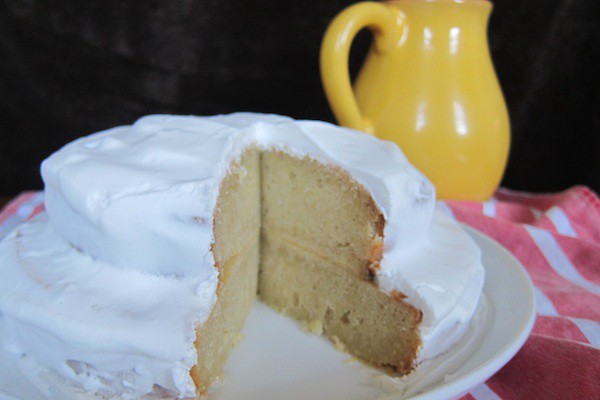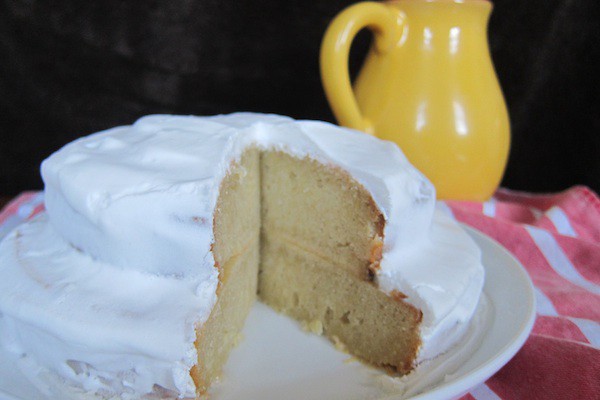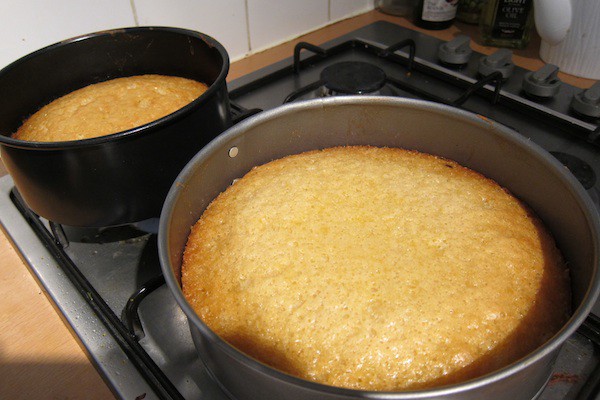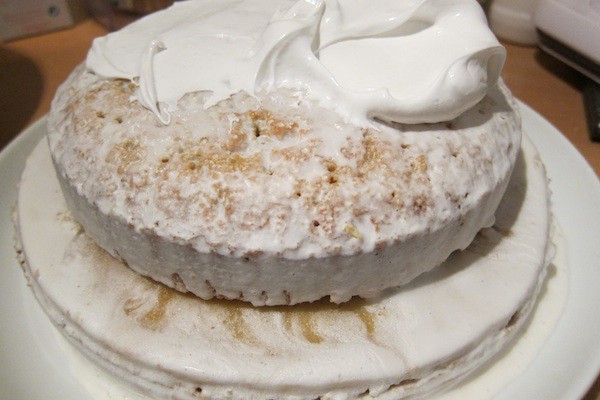Winter Survival: Laura Ingalls Wilder’s Birthday Cake
by Jessica Pan


That afternoon the finished black cashmere was carefully pressed, and then Ma made a big, white cake. Laura helped her by beating the egg whites on a platter with a fork, until Ma said they were stiff enough.
“My arm is stiffer,” Laura ruefully laughed, rubbing her aching right arm.
“This cake must be just right,” Ma insisted. — These Happy Golden Years, 1943
*That afternoon, Jess began separating 10 eggs as she attempted to make a traditional white cake from the pioneer years. Rachel helped her by watching.
“It says you have to beat the egg whites by hand to make it authentic,” Rachel said. Jess beat the eggs for 15 minutes and then rubbed her aching right arm.
“This is bullshit. I’m getting the electric mixer,” Jess said, heading towards the cupboard. — What actually happened, 2014
*Laura Ingalls Wilder would have been 147 years old today. To posthumously celebrate her birthday, I baked a popular cake from the frontier era — a beast of cake that calls for 14 eggs (not a typo) and intense arm power.
Technically, this was Laura’s wedding cake, but as the other cakes in the Little House Cookbook, Frontier Foods from Laura Ingalls Wilder’s Classic Stories, were comprised mostly of lard and flour, this is the closest we could get to a real birthday cake.*
Before you embark on your own culinary journey to pioneer times, I recommend that you enlist a trusty friend who will guide you when you shake the cookbook in disbelief and ask the gods who decided beating egg whites for an hour was a good idea and whether rose water is poisonous. I chose my friend Rachel, mostly because she is from Wisconsin, where Laura Ingalls Wilder was born and where the first book in the series, Little House in the Big Woods, took place. Also, some of these recipes called for massaging cold lard into flour and I could not bear to do this. Let’s begin.
Cake Ingredients:
1 cup of butter (feel free to churn the butter yourself, for authenticity)
2 cups of sugar
½ teaspoon baking soda
½ almond extract
½ teaspoon lemon extract
1 and 1/3 cup homogenized milk (don’t use skim milk as this was not fashionable)
10 egg whites
a pinch of salt
4 cups unbleached all-purpose flour
1 tsp cream of tartar
– Set out ingredients an hour before so they warm to room temperature. In a large bowl, cream butter until fluffy. Blend with the sugar until mixture is smooth. Add baking soda and almond and lemon extracts to the milk and then combine with butter.
– Add salt to the egg whites and beat them by tracing circles in the air that catch whites at bottom. The recipe also states, “We ask you beat the whites by hand not only to know what Laura felt but because the resulting texture will be different from that of machine-whipped whites.”
– As instructed, I beat the eggs with a fork and traced circles in the air and began to feel exactly like 18-year-old bride-to-be Laura, because whipping eggs is like using a time machine.
– The recipe states that it will take 10 minutes for stiff peaks to form, but even after 20 minutes, the stiff peaks never materialized. That’s okay! Do you think Laura Ingalls Wilder cried over uncooperative egg whites? No! Pioneer on.
– Preheat oven to 350 degrees, but don’t be too concerned on the exact temperature. Judge the heat the way the Ingalls family did back then: place your hand in the oven and when you can count to 20 but no more, then the oven is hot enough.
In a bowl, sift flour and cream of tartar. Sift again. Fold flour into sugar/butter mixture one large spoonful at a time, alternating with spoonfuls of egg whites. Blend. Divide the batter between two buttered cake pans and bake for 50 minutes.
“What is that weird smell?” you may ask again and again, as I did, before realizing it is the cake. It emits a very heavy, egg-y aroma, giving the kitchen an authentic prairie home scent.

After 50 minutes, the cooked cakes are a lovely toasted golden color. Let them cool and begin the frosting.
Sugar Frosting Ingredients:
4 egg whites
½ teaspoon cream of tartar
2 cups powdered sugar
½ rose water (make your own, like the old days)
2–3 tsp white flour
Rachel made the frosting, as my arms were tired from mixing the cake batter. She wanted the recipe to be historically accurate and also only used a fork when beating the eggs, with a similar result as mine: a thick viscous liquid that formed no peaks whatsoever.
The recipe says to beat the egg whites until they begin to foam. Add cream of tartar to egg whites and increase frothing. Add one tablespoon of powdered sugar at a time, beating after each addition, until soft peaks form and whites stick to the platter (this may never happen. Rachel stopped after 20 minutes of fork whisking).
For the final step, add rose water. Rose water smells like old lady perfume and tastes like it, too, but hey, it’s Laura’s birthday cake, not ours. The flowers were native to the prairie and Laura named her daughter Rose, so she must have been a big fan.
Dust the cake with flour and then spread frosting evenly on top and sides. This is when things may take a turn for the worse. Because we had failed to achieve stiff peaks with the frosting, it was merely absorbed by the cake, acting like white water, as it ran off the sides and then formed a white liquid moat around the bottom of the cake. It then dried and became rock hard, a reminder that eggs were also the main ingredient in paint during the early Renaissance.
To offset our first frosting failure, we made another batch using an electric mixer (coincidentally, invented the year Laura and Almanzo married. This would have been a fantastic wedding present for them). A few minutes later, the mixture was finally stiff, the frosting beautiful and fluffy. We spread it on thickly to hide our “authentic” watery frosting disaster. (Here is the difference between using an electric mixer and using a fork:)

Verdict: The cake was denser than pound cake. Perhaps in the frontier days, a heavier cake was ideal because if you ate one slice, the starchy, sweet food could power you up for the hard physical labor of frontier life and keep you satisfied for a week. (Alternatively, if you did not want to eat the cake, you could use it as a brick.) On the plus side, it has a very slight almond-extract flavor, but this was ruined by the rose water in the frosting. Rachel liked the cake flavor, but this may just be because this is how things are done in Wisconsin. However, she only managed a few bites before proclaiming she was very, very full and then declared the cake “poison.” Enjoy!
Next Week: Almanzo’s Apple Pie
*This was the bride’s cake but I encourage you to make the groom’s cake as well, which calls for a mere 50 eggs, five pounds of sugar, flour, butter, and brandy. The recipe yields 43.5 pounds of cake and lasts 20 years. Save me some for my 50th birthday.
Jessica and Rachel’s book, Graduates in Wonderland (Gotham), an epistolary memoir about living in Beijing and Paris, is out in May and available now for pre-order. Find out how the lard and buttermilk cakes turned out and other general nonsense here.